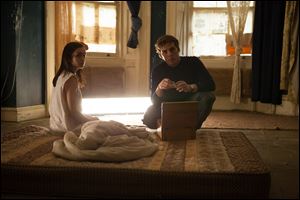
MOVIE REVIEW
‘Quiet Ones’ more creaky than creepy
4/25/2014
Olivia Cooke, left, and Sam Claflin in a scene from "The Quiet Ones."
Paying homage in style and theme to the vintage horror movies of the 1970s, The Quiet Ones is the latest stylish shocker from Hammer, the recently reactivated classic U.K. studio imprint. Mixing creaky haunted-house and exorcism tropes with a nod to the contemporary found-footage subgenre, the film relies on high production values and sense-battering shock tactics to make up for wooden performances and an illogical, silly script. As an exercise in retro pastiche, it impresses. But as a postmodern genre reinvention, it fails to deliver.
The sophomore feature of Washington-born screenwriter-turned-director John Pogue, The Quiet Ones boasts the usual vague claims to be “inspired by actual events.” It draws very loosely on the “Philips Experiment” of 1972, in which a group of Toronto academic researchers tried to prove that ghosts and poltergeists are constructs of the human mind. Needless to say, the original trials did not involve satanic cults, paranormal love triangles or high body counts, but reality can be disappointingly mundane like that. Print the legend.
Set in 1974, the film stars Mad Men veteran Jared Harris as Joseph Coupland, an Oxford University psychology professor with highly unorthodox methods. Coupland hires amateur cameraman Brian McNeil (Hunger Games regular Sam Claflin) to document his controversial experiments on Jane Harper (Olivia Cooke), a mentally unstable young woman who appears to be possessed by a diabolical alter ego named Evey. The professor believes Jane is creating Evey purely through her own telekinetic powers, and thus could hold the key to curing mental illness across the globe. His cutting-edge treatment, bizarrely, involves locking her in a cell-like bedroom and blasting her with loud rock music.
Directed by John Pogue.
Screenplay by Craig Rosenberg, Oren Moverman, and Pogue.
A Lionsgate release, playing at Franklin Park, Fallen Timbers, and levis Commons.
Rated PG-13 for intense sequences of violence and terror, sexual content, thematic material, language, and smoking throughout.
Running time: 98 minutes.
Critic’s rating: ★★
Driven out of Oxford by angry neighbors and nervous university authorities, Coupland and his team relocate to a crumbling country house straight out of the horror-cliche handbook. No other living souls for miles around? Check. Broken phone connection? Check. Spooky attic rooms? Check. Flickering lights that malfunction on an hourly basis? You get the picture. As the obligatory sexual tension begins to crackle between Brian and Jane — or is it Evey? — shocking revelations come to light about several key characters, and Evey’s poltergeist-like antics turn steadily more sinister. A bloody battle between scientific reason and supernatural evil follows.
Harris clearly relishes playing Coupland as a louche, chain-smoking, libidinous dandy, just a degree away from hammy mad-scientist caricature. In a vintage Hammer production, Vincent Price or Christopher Lee would have owned this role. The professor might be two-dimensional, but the rest of the cast is limited to one each. Claflin’s Brian is a pale cipher of naive goodness while his fellow researchers Kristina (Erin Richards) and Harry (Rory Fleck-Byrne) are thinly written eye-candy roles. All three are burdened with clunky dialogue and contrived plot exposition in place of character.
The Quiet Ones is not very original, nor even especially scary, and its title ultimately proves as meaningless as its plot. All the same, this genteel shocker earns its place in Hammer’s campy canon of superior B-movie schlock.